
 Most wind turbines are “horizontal axis,” pointing into the direction of the wind. “Vertical axis” turbines can capture wind energy from any direction, but current designs are less efficient and so get little attention and investment. Andrea Montanari at ECECP looks at innovative companies around the world that are trying to leverage the other advantages they have over the dominant horizontal versions. They are more stable (lower centre of gravity), and the turbine is easier to access for installation and maintenance (its mechanics are at ground level). They can be packed closer together. Their omnidirectional design means they are ideal for siting where there is no prevailing wind direction or when that wind changes its direction throughout the day, like in cities. Small ones can even be attached to street lighting or placed on buildings. Larger designs can be used in remote off-grid, cold, dark places with extreme weather locations, unlike solar. As for offshore, construction is now underway in Norway of a commercial-scale 1-MW turbine, with an expected Levelised Cost of Energy of below €50/MWh. With scale-up, efficiency should go up and prices down, says Montanari.
Most wind turbines are “horizontal axis,” pointing into the direction of the wind. “Vertical axis” turbines can capture wind energy from any direction, but current designs are less efficient and so get little attention and investment. Andrea Montanari at ECECP looks at innovative companies around the world that are trying to leverage the other advantages they have over the dominant horizontal versions. They are more stable (lower centre of gravity), and the turbine is easier to access for installation and maintenance (its mechanics are at ground level). They can be packed closer together. Their omnidirectional design means they are ideal for siting where there is no prevailing wind direction or when that wind changes its direction throughout the day, like in cities. Small ones can even be attached to street lighting or placed on buildings. Larger designs can be used in remote off-grid, cold, dark places with extreme weather locations, unlike solar. As for offshore, construction is now underway in Norway of a commercial-scale 1-MW turbine, with an expected Levelised Cost of Energy of below €50/MWh. With scale-up, efficiency should go up and prices down, says Montanari.
Imagine you are a Persian farmer living in Khorasan, sometime around the 7th century CE. You are making your way home after a long day of work, not far from the Nashtifan windmills that tower over the landscape. As you are approaching home, you feel a subtle shift in the air, a gentle breeze that anticipates the coming of the summer. You know this wind well: it is the Sistan wind, a blessing from nature that carries the promise of prosperity for your crops.
The Sistan wind begins to pick up, its cool breath rustling through the golden fields of grain. You watch as the wind catches the sails of the Nashtifan windmills, setting them into motion with a rhythmic cadence. The wooden blades begin their tireless spin, harnessing the power of the wind to grind grain into flour. This timeless dance of nature and technology has sustained your people for generations, and will accompany you throughout the summer, until the wind subsides in the quiet of October.
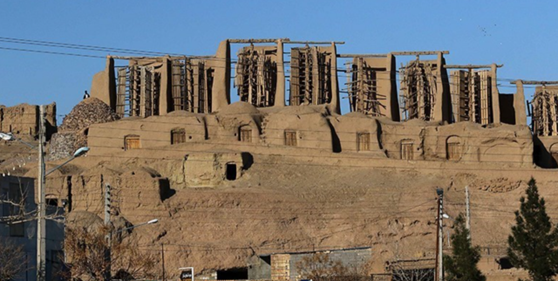
Image 1: Nashtifan windmill complex, Iran / SOURCE: Tasnim News Agency, CC BY 4.0.
The Nashtifan Windmill Complex represents one of the first attempts to harness the power of wind for human activity. Situated in the Khorazan Razavi province in modern-day Iran, these windmills are also one of the first examples of windmills designed with a vertically-oriented rotor, and are still operational today. The construction of the complex was designed to take advantage of the geographical features of the region, characterised by persistent winds blowing from deserts in Central Asia towards the Iranian Plateau. The Sistan wind, known as the ‘120-day wind’ owing to its duration spanning four summer months, usually blows at an average speed of 30 to 40 km/h, but can occasionally reach 100-110 km/h. This unique feature created the opportunity to turn wind into mechanical energy. Through a vertical un-geared shaft, the movement generated by the wind directly turns a large stone mill wheel. The large rotating stone then grinds wheat into flour.
From ancient windmills to modern turbines
In spite of its early applications, vertical rotors were slowly abandoned in favour of their horizontal-axis counterparts, especially in Europe in the Middle Ages. If you ask a toddler to draw a windmill, it is likely the sketch will more closely resemble windmills from, say, the Netherlands, than the Persian windmills of Nashtifan. Yet, thanks to the potential unleashed by new designs and technological innovation, Vertical-Axis Wind Turbines (VAWTs) are suddenly making a comeback.
Broadly speaking, the technology is the same as it was for the Nashtifan windmills. As the wind comes into contact with the blades, which are attached to a vertical rotor, it causes the rotor to spin, creating kinetic energy which can then be turned into electricity through a generator, or mechanical energy to perform other tasks. What really has changed is the design. There are two main models, the ‘Savonius’ and the ‘Darrieus’, both of which were developed in the 1920s. There are also alternative subsequent designs, such as the H Rotor – a Darrieus turbine with straight blades – and the helical model – an H Rotor with helical-shaped blades. (See Images 2-3-4-5).
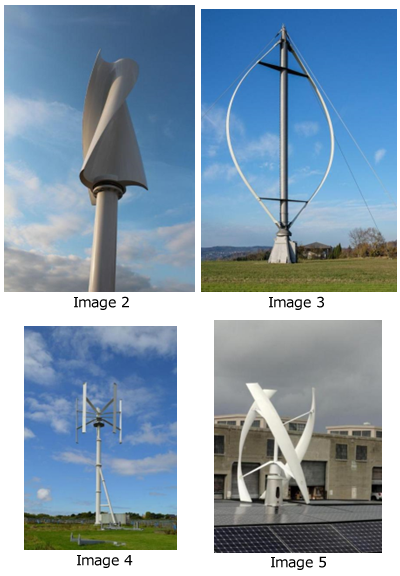
Image 2: A Savonius wind turbine / SOURCE: Wikimedia, CC BY-SA 2.0 de.
Image 3. Darrieus wind turbine with curved blades / SOURCE: Dietrich Krieger, CC BY-SA 3.0.
Image 4: ‘H Rotor’ Darrieus turbine with straight blades / SOURCE: Munro89 – Own work, CC BY-SA 4.0
Image 5: Darrieus wind turbine with helical blades / SOURCE: Rehman Abubakr, CC BY-SA 4.0
For small-scale wind production…
Unlike the windmills in Nashtifan, these designs would look great on your balcony. In fact, nowadays the main application for this kind of turbine is for small-scale wind production. The large-scale market is still dominated by Horizontal-Axis Wind Turbines (HAWTs), because they have better efficiency and better performance for wind farms. The efficiency of an HAWT is on average between 40% and 50%[1], compared to an average of 35% to 40%[2] for Darrieus types, and a maximum of 20% for Savonius turbines. So, given the higher electricity yields, the choice for large-scale investments usually falls on HAWT models. Moreover, as large vertical-axis wind turbines are still less prevalent than their ‘fan-on-a-stick’ peers, this results in fewer manufacturers, smaller supply chains, and not as many benchmarks to assess reliability and performance.
…and it’s omnidirectional!
Yet for small-scale wind production the situation is different. To begin with, these vertical-axis turbines are omnidirectional. In other words, it doesn’t matter which corner the wind is blowing from: they will keep spinning regardless. They are also very silent – they wouldn’t bother your elderly neighbours’ afternoon siesta – and they come in different colours, sizes and shapes. For instance, Dutch company Flower Turbines – whose name leaves little to the imagination – has launched models of tulip-shaped VAWTs (see Image 6 below), in case you ever thought of giving a flowery touch to your mansion.
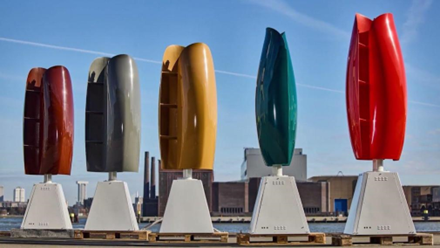
Image 6: A bouquet of medium-size tulip-shaped wind turbines / SOURCE: Flower Turbines
Even more importantly, vertical-axis wind turbines work well together – unlike traditional HAWTs – and they can be installed closer to each other. This is called, in engineers’ jargon, ‘wake effect’: in short, when the wind hits the turbines’ blades, it creates a turbulence that ‘distorts’ the wind stream and can negatively affect the performance of downstream turbines. For this reason, large vertical-axis wind turbines must be duly distanced when grouped together in a wind farm. But here’s the good news: due to their vertical rotor, this effect is extremely reduced for vertical-axis turbines. In fact, in some cases it can even enhance their performance. Hence, VAWTs can have a closer spacing between each other, which allows for a more efficient use of tight urban spaces. See Image 7 below.
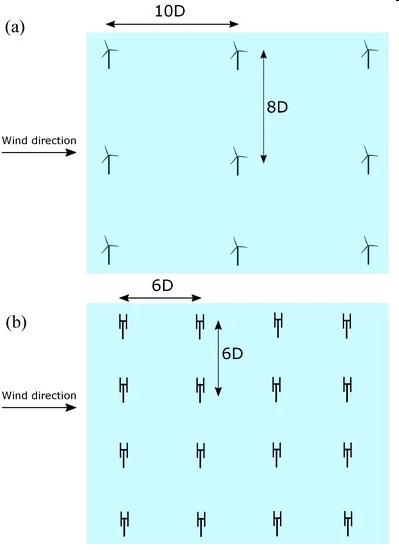
Image 7: Reduced ‘wake effects’ allow for closer spacing between turbines within a wind farm / SOURCE: Arredondo-Galeana, Abel & Brennan, Feargal. (2021). Floating Offshore Vertical Axis Wind Turbines: Opportunities, Challenges and Way Forward. Energies. 14. 8000. 10.3390/en14238000.
Small-scale Vertical-Axis Wind Turbines in urban areas
Given the properties listed above, it is no surprise that small vertical-axis wind turbines find their main applications in urban areas. Innovative eye-catching designs are facilitating their integration into the urban landscape. Take, for example, the models developed by New World Wind, a French company. Instead of relying on a single, compact turbine, their ‘aeroleaf technology’ consists of many leaf-shaped micro-turbines integrated in a tree-like structure, which can also be complemented by petal-shaped solar panels (Image 8 and 9). If green energy alone wasn’t enough, it is now incorporated into a ‘green’ design, too. Twice the green, twice the fun.
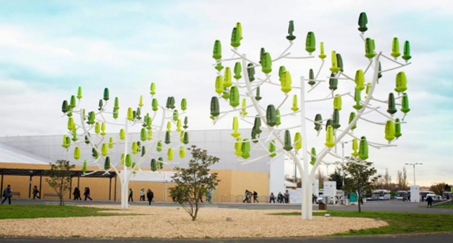
Image 8: Two ‘Wind Trees’ integrated into the urban landscape / SOURCE: New World Wind

Image 9: Petal-shaped solar panels integrated into a Wind Tree / SOURCE: New World Wind
The potential for vertical-axis wind turbines in cities is also demonstrated by their easy integration with other urban structures. Some can even reach world record-breaking scales. For instance, Venger Wind and US renewable distributor SWG Energy made news after installing 18 omnidirectional wind turbines on the top of the Oklahoma Medical Research Foundation, in Oklahoma City (Image 10). The project has been awarded the World Record Academy-certified title of ‘World’s Largest Rooftop Wind Farm’[3] and offers a blueprint for replication in different contexts, delivering a clear message: yes we can (… produce clean energy in cities thanks to this technology).
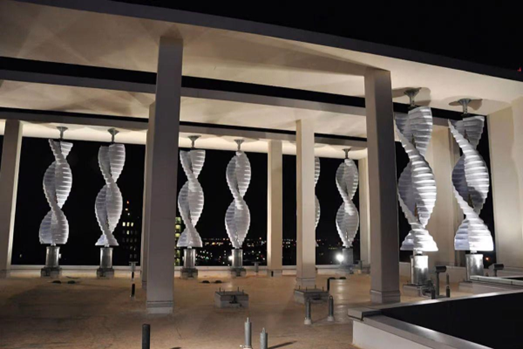
Image 10: Wind turbines installed on the rooftop of the Oklahoma Medical Research Foundation, Oklahoma City / SOURCE: World Record Academy.
Streetlights
Streetlights go hand in hand with VAWTs, and can be further integrated with solar panels (Image 11). In particular, several studies suggest that highways[4] offer an opportunity to harness wind potential for street illumination. Owing to the high speeds and the opposing direction of travel, cars generate windflows that can be captured by VAWTs. As the slipstream from cars comes in opposing directions, a vertical-axis turbine installed in the middle of the road could effectively harness the wind energy from both sides, thus reducing traditional negative forces applied on the blades. This intuition lies at the root of the VAWT model proposed by Capture Mobility, a Scottish company (Image 12). According to this concept, each Savonius-like turbine can generate up to seven KW of electricity a day[5] – enough to power a household – although results can vary based on speed and traffic conditions.
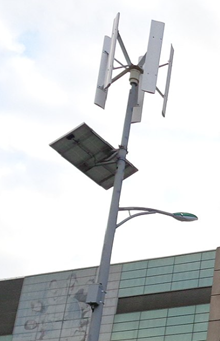
Image 11: A VAWT integrated with a solar panel to power a streetlight / SOURCE: Tdorante10 – Own work, CC BY-SA 4.0.
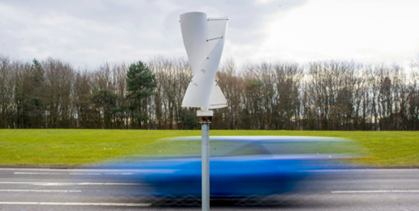
Image 12: The Savonius-like model installed by Capture Mobility to harness airflow from cars / SOURCE: Capture Mobility
Improving VAWT efficiency
Of course, the location of the turbines is just one element: another element is the technology involved. Innovative designs are being developed to improve VAWT efficiency. Due to their own traditional shapes, Savonius and Darrieus turbines have different performances and different starting speeds. In fact, Savonius turbines are self-starting and work well with very low wind speeds, although they can have limited efficiency. On the other hand, Darrieus turbines work better with stronger winds, but need an initial push to operate – usually provided by a small motor. If these models respond to different wind conditions, then why not put them together in an all-weather turbine capable of working with both light summer-night breezes and heavy stormy gusts of wind? Developers at Hi-VAWT, a Taipei-based company, had just this idea. The model they propose is a mix of the two, integrating a smaller drag-type Savonius turbine within the larger blades of a Darrieus (Image 13 and 14), thus offsetting the respective shortfalls of traditional models.
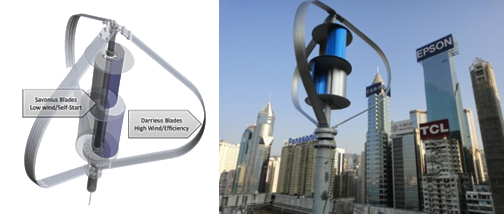
Image 13, 14: Model of a DS series turbine (left) and a DS-1500 VAWT installed in Hong Kong (right) / SOURCE: Hi-VAWT Technology Corp.
There are also more sophisticated designs. A promising one is the multi award-winner ‘O-Wind’ (Image 15), developed by two students at Lancaster University. Its innovative spherical structure builds on the ideas behind NASA’s Mars Tumbleweed Rover, but it is optimised for harnessing wind power. Due to its particular shape, the turbine is capable of absorbing wind from every direction, with better efficiency than traditional VAWTs. The O-Wind turbine has been specifically designed for high-density urban environments where the architecture of tall buildings throws wind flow into chaos, making conventional turbines less effective. In contrast, the O-Wind design is suited for small-scale production, and can easily be fixed on balconies or the sides of buildings, where speeds are high, or on traditional poles and streetlights. Some even suggest that, after its initial commercialisation in 2024, this new model could outperform solar panels for urban clean energy production.[6]
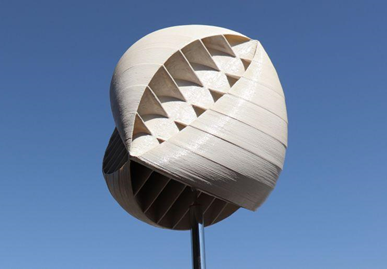
Image 15: Model of an ‘O-Wind’ turbine / SOURCE: O-Innovations
Applications for larger VAWTs: remote off-grid, cold, dark, extreme weather locations
Although small-scale wind production for cities represents the lion’s share of VAWT applications, there are other niches in the market where medium- and large-sized VAWTs may be more helpful than HAWTs to cut carbon emissions.
A first and important example is the potential for VAWTs to power off-grid or remote locations, especially in extreme weather conditions. Currently, numerous remote communities in regions of Europe, Asia and North America remain disconnected from the electricity grid. Reliance on diesel or propane generators for electricity and heating in these locations is both costly and labour-intensive, notably due to the expense and effort involved in fuel transportation. Solar systems can offer a viable alternative, but – especially in the northernmost areas – sunlight is often absent, and frequent precipitations can cover solar panels with snow. How to reduce reliance on fossil fuels in harsh and cold climates like Canada, European Nordic countries, northern China, or Russia? Here, larger-scale VAWTs can prove to be effective. Compared to traditional HAWTs, vertical-axis turbines are better equipped to sustain persistent extreme conditions, such as storms and temperatures well below zero. Moreover, due to their particular design, there are fewer moving parts compared to HAWTs, and the main components, including the generator, are located in the base, instead of being on top of a 120-metre tall tower. This makes maintenance and repairs much easier – a significant incentive when you are operating in conditions that make life harder even for bacteria.
No wonder, therefore, that one of these adversity-proof models comes from the land of ice and fire – Iceland. The vertical-axis wind turbines developed by IceWind, an Icelandic company, are purposely designed for easier installation at the ground level (Image 16) or on structures hit by strong winds, such as telecommunication towers (Image 17). Although their performance might be lower when compared to traditional onshore HAWTs, these resistant turbines can offer an alternative where difficult weather conditions make the installation of conventional turbines impossible. It is calculated that, for the average electricity consumption of a European household, about three ‘Freya’ turbines – one of IceWind’s models – are needed to fully power an off-grid home[7] (Image 18). Even when houses are connected to the grid, these VAWTs can generate supplementary energy to cut consumption of fossil fuels.
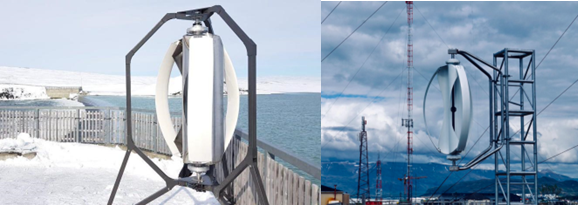
Image 16,17: ‘Njord’ series turbines installed on the ground (left) and mounted on a telecommunication tower (right) / SOURCE: IceWind
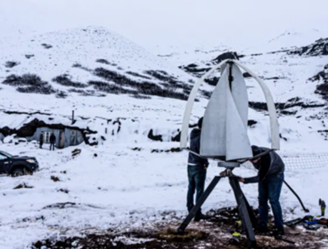
Image 18: Installation of a Freya Turbine / SOURCE: IceWind
Offshore Wind
In addition to onshore deployment, new VAWT applications are being studied for offshore wind production. In fact, due to their different design, Darrieus-type turbines offer a viable alternative to Floating Offshore Wind Turbines (FOWTs). Vertical-axis FOWTs present more static stability – owing to their lower centre of gravity – and reduced wake effects. As a result, a lighter and less expensive foundation is required, and turbines can be installed closer together, reducing the maritime area occupied, and increasing the wind farm power density[8]. Once again, an important advantage of vertical-axis FOWTs is that they are easier to maintain: descending from a helicopter like Tom Cruise in Mission Impossible might sound like a fun activity to adrenaline-seekers, but it can hardly compete with the comfort of getting what you need at sea level.
The idea of VAWT offshore wind farms is gaining traction, and some projects have recently been announced. In 2022, Swedish company SeaTwirl signed a deal with Westcon to build and deploy a commercial-scale 1-MW turbine offshore Norway, and construction is now underway. The S2x-model will consist of a three-bladed H Rotor, reaching 55 metres above the sea level and designed to withstand extreme wind speeds of up to 50 m/s[9] (Image 19). According to a document released by the company[10], it is also expected to produce energy at a mature Levelised Cost of Energy of below EUR 50/MWh, thus bringing floating offshore much closer in cost to onshore wind.
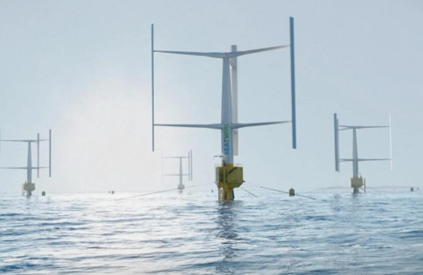
Image 19: SeaTwirl vertical-axis wind turbines in an offshore wind farm / SOURCE: SeaTwirl
Likewise, Norwegian company World Wide Wind announced a revolutionary design for vertical-axis floating offshore wind turbines, consisting of a ‘contra-rotating vertical turbine’, or – as the company calls it – ‘CRVT’. The design features two sets of V-shaped blades tuned to rotate in opposing directions, and the towers are intended to tilt with the wind, thus further reducing the wake of each turbine and accounting for closer spacing between them (Image 20). The project is still in its initial stages, but this innovative design promises a revolution in offshore wind production.
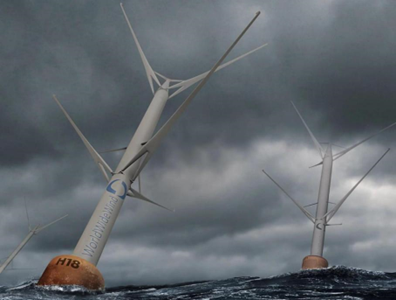
Image 20: What World Wide Wind’s contra-rotating vertical turbines will look like / SOURCE: World Wide Wind
In conclusion, from ancient Persian windmills to modern-day designs, vertical-axis wind turbines have played an important role in harnessing the power of wind. More companies are seeing the potential for this technology to generate power in geographically challenging areas or in conurbations. Although the wind power market is still dominated by their horizontal-axis counterparts, VAWTs have unique features that make them more attractive for specific niche applications to decarbonise our economies. With their potential to be more stable, more easily maintained and easier on the eye, the role of VAWTs in wind power generation is likely to grow. Moreover, VAWTs offer a way of capturing wind in urban environments with a space-saving technology that other wind technologies cannot currently match. The road to carbon neutrality is paved with good intentions but is far from being smooth sailing: whether on land or sea, vertical-axis turbines offer a promising solution to maximise the use of wind to power the transition.
***
Andrea Montanari is a Junior Postgraduate Fellow of the ECECP
This article was first published in the EU-China Energy Magazine – April Issue, available in English and Chinese, and is published here with permission
NOTES:
- Luvside, ‘Horizontal wind turbines: advantages & disadvantages’, link: https://www.luvside.de/en/hawt-advantage-disadvantage/#:~:text=High%20Efficiency&text=Currently%2C%20horizontal%20axis%20wind%20turbines,received%20wind%20power%20into%20electricity. ↑
- The American Society of Mechanical Engineers, ‘Vertical-Axis Wind Turbines Work Well Together’, link:https://www.asme.org/topics-resources/content/vertical-axis-wind-turbines-work-well-together ↑
- World Record Academy, ‘World’s Largest Rooftop Wind Farm: world record in Oklahoma City, Oklahoma’, https://www.worldrecordacademy.org/2023/11/worlds-largest-rooftop-wind-farm-world-record-in-oklahoma-city-oklahoma-423524 ↑
- S.Krishna Kumar, P. Kumaresan, R. Praveen, J. Udaya Prakash, ‘Power generation using windmills using movements of vehicles in highways’, available at: https://www.academia.edu/44071013/IRJET_POWER_GENERATION_USING_WINDMILL_USING_MOVEMENT_OF_VEHICLES_IN_HIGHWAYS?rhid=27796546844&swp=rr-rw-wc-43768196 ↑
- Design Indaba, ‘Capture Mobility turns airflow from passing cars into electricity’, link: https://www.designindaba.com/articles/creative-work/capture-mobility-turns-airflow-passing-cars-electricty ↑
- Future Galaxy, ‘This NEW European Wind Turbine for Home Outperform PV Solar Panels in 2024?!’, YouTube link: https://www.youtube.com/watch?v=mDBNFY2BXKU ↑
- Sana Kazilbash, ‘Can IceWind’s Six-Bladed Microturbines Power Off-Grid Homes?’, link: https://www.engineering.com/story/can-icewinds-six-bladed-microturbines-power-off-grid-homes ↑
- For a detailed comparison between HAWTs and VAWTs deployed in offshore wind farms, see: A. Ghigo et al., ‘Floating Vertical Axis Wind Turbines for offshore applications among potentialities and challenges: A review’, available at: https://www.sciencedirect.com/science/article/pii/S136403212400025X#:~:text=Among%20the%20primary%20uses%20of,which%20are%20not%20grid%2Dconnected. ↑
- NewAtlas, ‘1-MW floating vertical axis wind turbine to be deployed off Norway’, link: https://newatlas.com/energy/seatwirl-vawt-norway/ ↑
- Available at: https://seatwirl.com/content/uploads/LCoE-SeaTwirl-1.pdf ↑
- SEO Powered Content & PR Distribution. Get Amplified Today.
- PlatoData.Network Vertical Generative Ai. Empower Yourself. Access Here.
- PlatoAiStream. Web3 Intelligence. Knowledge Amplified. Access Here.
- PlatoESG. Carbon, CleanTech, Energy, Environment, Solar, Waste Management. Access Here.
- PlatoHealth. Biotech and Clinical Trials Intelligence. Access Here.
- Source: https://energypost.eu/the-benefits-of-vertical-axis-wind-turbines-omnidirectional-close-packed-easier-to-maintain-more/

